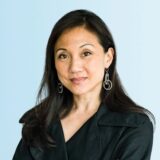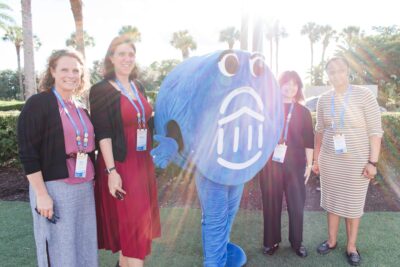How the first-gen experience prepared CSU’s chancellor for the job
Dr. Joseph Castro, newly appointed chancellor of California State University and former President of Fresno State, recently sat down with EAB’s Chief Partner Officer Sally Amoruso to discuss how his experience as a first-generation student led him to pursue a career in higher education and how it has made him a more compassionate leader.
(Note: The interview below has been edited for length and clarity by Kristina Azevedo)
SA: It’s striking how aligned your personal experience is to your position and the CSU system. Can you share your path to public higher ed as your career and calling?
JC: I serve as chancellor because of the experiences I had early on as a student. Like so many of the students I serve now, I was a first-generation college student. I remember what a leap that was to go from a small high school in California’s mostly rural Central Valley to the University of California, Berkeley, which was larger than my hometown. That was a big change for me and my family. It was over the course of that experience where I thought, “This is changing my whole life.”
Higher ed has the ability to change lives on a large scale. That’s what got me interested in higher education as a career. My educational experiences laid the groundwork for what I’m doing now, especially during such a consequential time to serve as chancellor. I feel very fortunate and challenged at the same time.
SA: What was it like as a first-generation student at UC Berkeley?
JC: I became a first-generation student at UC Berkeley because I had a counselor in my high school who knew I was UC-eligible. He also knew I was planning on going to the local community college because that was what I understood from my family was the right path. He rocked my world one day by calling me in and saying, “Joe, the University of California is interested in more students from the Valley. There’s a meeting in Fresno if you would like to go there and learn more. Take your application in case you want to apply.”
I talked to my mom about it and she said, “Why not? Let’s go listen.” After the presentation, the admissions counselor read my application and stamped my application “admitted” right there. My mom and I were stunned. It changed my whole life, being admitted like that.
SA: What insights did you learn serving as Fresno State’s president that you will take into the chancellorship of the system?
JC: I’m still processing how different this job is. The way in which I needed to lead at Fresno State during the pandemic is helping me now. I’ve found that I need to stay flexible around strategies and solutions because this is such a fluid environment. I try to always remember our mission and values to make sure I don’t jump to a conclusion too soon.
So many times throughout this pandemic, I’ve been with groups of presidents who had really strong feelings like, “We can’t do that, that’s crazy.” I’ve tried to remind myself that what might sound crazy today could be a great solution tomorrow. That’s been a very powerful lesson for me.
I make sure I take the time to stay connected to my colleagues, to understand the challenges that they are going through—the stress and strain—so that we can be effective together. We need to try to be compassionate, reasonable, and flexible in the work we are doing. This is not a time to be rigid and put up barriers. I ask, “How do we make this a little bit easier for everybody to learn during such a challenging time?” This has made me even more compassionate than I was before.
“We need to try to be compassionate, reasonable, and flexible in the work we are doing. This is not a time to be rigid and put up barriers.” – Dr. Joseph Castro
SA: What are the greatest threats or challenges you see as CSU emerges from COVID?
JC: Repopulating our campuses in the fall is one big challenge that our leaders are talking through together. We’re following the science and sharing different strategies. It’s a huge challenge to make sure we get that right; I still don’t know how that’s going to look, but we are planning to have a majority of courses in person this fall.
Another challenge I want to focus on is addressing equity gaps, especially around underrepresented students. I’d like to accelerate our progress around faculty diversity. We want our faculty to better reflect the diversity of our students that we serve. We may have the ability, with new resources from the state, to strategically hire more underrepresented folks as faculty. We would like to take that opportunity because it will support our student success goals.
SA: What opportunities, perhaps even silver linings, do you see post-pandemic?
JC: We had to pivot from in-person to largely virtual in a matter of a couple weeks. We’ve learned a lot since that happened. In my conversations with professors throughout the system, many feel like they are teaching more effectively than ever before. I also hear how much stress they are under. The silver lining that I can see is that we can focus more on innovation once we get beyond the pandemic. We will be in a stronger place.
I also see the opportunities for flexibility for those who can’t come to a campus every day. We will be in a position to offer students more hybrid or virtual courses. I want to empower more hybrid and more virtual offerings as we continue to strengthen our in-person courses. It might open new opportunities for recruiting staff if they don’t need to be on campus every single day.
SA: California is a vast and diverse state; likewise, the system encompasses 23 diverse campuses serving different communities in different settings across the state. How do you leverage the power of the collective as a system while also enabling each campus to establish strategies specific to serving their student populations?
JC: That’s the central challenge of a position like this. Coming to the chancellorship as a former president, I want to make sure each campus has the flexibility to grow and thrive. I’m trying to make sure they have the resources and information to make critical decisions. I’m going to try to use the system to share best practices that will benefit all campuses and avoid cookie cutter solutions. We need to be more flexible than that. It’s so important for me in 2021 to value each campus’s story and what they are doing in their part of California. As chancellor, I’m going to support them to be even stronger and meet their regional needs.
SA: What do you hope will be your legacy as the leader of this system?
JC: I don’t want us to just be the largest, most diverse public university in the country. I also want us to be universally embraced by everyone in California and beyond. That will involve getting our alumni and their families engaged to build that support.
I also want my legacy to include the elimination of equity gaps that exist. It’s doable with EAB’s help. We actually know how many students need to graduate to eliminate these gaps at each campus. I want that to be one of our legacies together.

More Blogs

Four signs it’s time to break up with your student CRM

EAB experts reflect: The conversations that defined higher ed in 2025
